California Gold Quartz Specimen Natural Gold Nugget 2.33 Gram Gold In Quartz
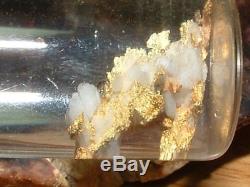

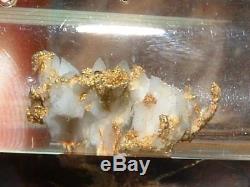
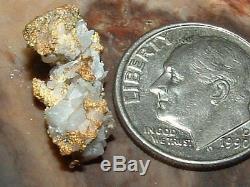
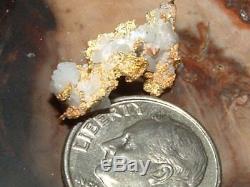
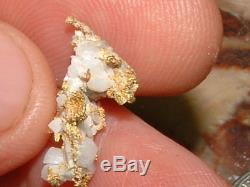


NATIVE GOLD QUARTZ SPECIMEN from the MOTHER LODE. R uler is 1/4 wide (6 mm). 10 cent coin is 17 mm in diameter. S pecimen weight: 2.33 G ram - 35.8 G rains. S ize: 18.8X9.8X7.7 mm.
I f you've an eye for gold straight from the earth, check out this beautiful and rich gem from the Sierra Nevada Mtns. This rich chunk of rock, but mostly gold, is more like a gnarly nugget with quartz attached. Total weight is 35.8 grains (Troy). Someone asked me recently if I had any'rose gold'. Well this, to me, fits that description. Gold will sometimes come in different colors and purities within the same formation and occurrence. It's not often talked of, but here's a cool example of bi-color gold. There's yellow and then there's super-yellow gold mixed together here. It even grades into gold which looks quite coppery. Minute amounts of a black mineral are also associated with the gold.I daresay she's quite the attractive and interesting piece of California Gold Mining history. Unfortunately, my source did not know what California mine or even mining district it comes from. I suspect Sierra County's 16 to 1 Mine. B ack when I actively mined, nuggets would sometimes show up with host rock i. Searching further up-slope, it was common to see quartz outcroppings containing vein filling similar to the matrix in my nugget.
Naturally, one began to wonder if this might be the same vein which shed your specimen. During my prospecting years, there were instances when gold-producing veins were located in this manner; however, because of the enormous cost and difficulty in developing a lode deposit, I preferred leaving lodes to the hard-rock miners. The thing with these types of discontinuous fissure veins is that ore tenor is rarely consistent in it's richness. Assays, if commission work is required, are rather expensive as well. In pocket country however, whenever a potential source of eroding placer gold is found in the form of an attractive vein system, it's advisable to take samples and detect the heck out of it.
You might get lucky and discover a pocket or lens on a quartz vein which is still shedding-gold. Generally-speaking, placer was my focus, and no matter how disfigured, discolored, deformed, or impure a nugget might be, I never found a piece of gold I didn't like. It takes a lot of effort to find gold whether it's placer or a pocket, so there's really no such thing as an'ugly nugget'. Each one is beautiful in it's own way. I guarantee the gold growths here are a natural occurrence.All my specimens show visible gold and are authentic gold quartz specimens. I don't paste'pounded gold' or spray gold-colored paint on barren rock.
Refractory ores, which need to be heated and run through special processes to release the minute amount of gold locked up inside, aren't usually my thing. When I do sell sulphides, you'll be able to see gold associated with the pyrites. You won't need to crush and treat my rocks with cyanide solution to get at the gold.
We're not dealing in micron gold. I deal in genuine high-grade, naturally-occurring gold quartz with visible gold, both as specimen and as jewelry-grade slab. Such rich rocks and lapidary rough are hard to find and expensive to obtain. I poured through old mining dumps for years looking at orange-yellow-rusty rock through a loupe, but I never found a piece with visible gold. Hydrothermal solutions carrying gold and silica crystallized into veins of gold quartz.
This specimen comes from one of the many vein systems sourcing the immense placer deposits of the Sierra Nevada Mtns, the famed Mother Lode. 15.43 GRAINS = 1 GRAM. 31.103 GRAMS = 1 TROY OUNCE.24 GRAINS = 1 PENNYWEIGHT (DWT). 20 DWT = 1 TROY OUNCE. 480 GRAINS = 1 TROY OUNCE. We leave no stones unturned insuring our customers get what they bargained for.
If you're not satisfied with this item, contact me. I n river systems containing an enormous volume of sedimentary rock, how do you know where to dredge? One basic truth about pay-streaks in drainages is pretty much a given. Look for the largest boulder packs downstream from an inside bend.
Between bends, if it's possible to see portions of true bedrock, or'country rock, look for upthrust projections and large boulders. Downstream from those are ideal deposition zones. That's where placer gold lives.
The same holds true in ancient river channels now stranded high above present day water tables. Irregular, undulating bedrock thrust up like peaks and pinnacles in between smoother, flatter stretches of bedrock creates eddies where gold traveling downstream in swift water may drop out and remain usually in cracks and pockets in bedrock or just above bedrock. If you're mining on public lands, it will probably be necessary to file a notice of intent to operate or plan of operations detailing the manner in which you intend to mine. Naturally, many small-scale miners wish to avoid such bureaucratic obstructions to one's progress.Best to g ive this choice serious consideration. There could be serious consequences for those who refuse to follow the rules. If, on the other hand, you explain to Gov what you intend on doing and how you'll clean up your mess once you're done, you'll most likely be far better off in the long run. Maybe there's a snippet of good advice here for those wishing to avoid an unpleasant situation with the Federales. Once authorization has been issued (providing it's issued) and you're good to go, if not too monstrous, boulders can sometimes be nudged out of the way with a pry bar.
Use the largest bar you can find... Words of caution: Know your limits. It's easy to hurt your back and other parts of one's anatomy. Oh, I think I hurt myself! Develop the area you plan on prospecting carefully.
As you're sucking gravel (if you are using a suction dredge) and moving larger rocks, frequently survey your hole for hazards. Always bring down any'hanging boulders' before working in their vicinity. This is definitely not rocket science. It's the rocks you knew about, but neglected, that get you. A buddy once had his leg broken by a boulder coming down on him from behind.Danger is imminent at all times when dredging underwater. Exhale the air in your lungs if you experience an emergency and have to surface rapidly. Develop the philosophy of'safety comes first, gold is secondary'. The weight you can move underwater using nothing but your brawn is astounding, but why risk injury when there's mechanized winches and other powered tools available? Let me reiterate that Permits are generally required, so check on the regulations before moving boulders.
Thanks for checking out our digs. G old of E ldorado 1-14-13.
The item "CALIFORNIA GOLD QUARTZ SPECIMEN NATURAL GOLD NUGGET 2.33 GRAM GOLD IN QUARTZ" is in sale since Saturday, January 20, 2018. This item is in the category "Collectibles\Rocks, Fossils & Minerals\Crystals & Mineral Specimens\Precious Metals". The seller is "egm947" and is located in Banks, Oregon. This item can be shipped worldwide.

